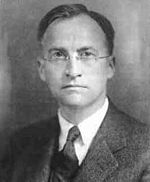George David Birkhoff
| George David Birkhoff | |
|---|---|

George David Birkhoff
|
|
| Born |
March 21, 1884 Overisel, Michigan |
| Died | November 12, 1944 (aged 60) Cambridge, Massachusetts |
| Nationality | American |
| Fields | Mathematics |
| Institutions |
Harvard University Yale University Princeton University Radcliffe College |
| Alma mater | University of Chicago |
| Doctoral advisor | E. H. Moore |
| Doctoral students |
Clarence Adams David Bourgin Raymond Brink Robert D. Carmichael Hyman Ettlinger Bernard Koopman Rudolph Langer Charles Morrey Marston Morse G. Baley Price I. M. Sheffer Marshall H. Stone Joseph L. Walsh Hassler Whitney David Widder Kenneth Williams |
| Known for | Ergodic theorem |
| Notable awards |
Bôcher Memorial Prize (1923) Newcomb Cleveland Prize (1926) |
George David Birkhoff (March 21, 1884 – November 12, 1944) was an American mathematician, best known for what is now called the ergodic theorem. Birkhoff was one of the most important leaders in American mathematics in his generation, and during his time he was considered by many to be the preeminent American mathematician.His house in Cambridge, Massachusetts, has been designated a National Historic Landmark.
He was born in Overisel Township, Michigan, the son of David Birkhoff and Jane Gertrude Droppers. The mathematician Garrett Birkhoff (1911–1996) was his son.
Birkhoff obtained his A.B. and A.M. from Harvard. He completed his Ph.D. in 1907, on differential equations, at the University of Chicago. While E. H. Moore was his supervisor, he was most influenced by the writings of Henri Poincaré. After teaching at the University of Wisconsin and Princeton University, he taught at Harvard University from 1912 until his death.
In 1923, he was awarded the inaugural Bôcher Memorial Prize by the American Mathematical Society for his paper Birkhoff (1917) containing, among other things, what is now called the Birkhoff curve shortening process.
He was elected to the National Academy of Sciences, the American Philosophical Society, the American Academy of Arts and Sciences, the Académie des Sciences in Paris, the Pontifical Academy of Sciences, and the London and Edinburgh Mathematical Societies.
...
Wikipedia
